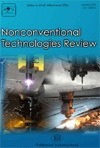NONCONVENTIONAL RADIOLOGICAL TECHNOLOGIES AND PROCESSES USED FOR NEUROSURGERY IN CORRELATION WITH INTELLECTUAL PROPERTY PROTECTION WITH DIRECT APPLICATION IN HEALTHCARE ORGANIZATION
Abstract
Nonconventional radiology systems have evolved significantly through the integration of PACS (Picture Archiving and Communication Systems) technology, which has revolutionized the way in which images captured by CT, MRI, radiology devices are stored, distributed and accessed. PACS facilitates the efficient management of radiological CT images, providing fast and secure access to patient data. This work considerably simplifies the process of diagnosis and planning of neurosurgical treatment. This IT solution can integrate and structuring medical data in an organized manner. Using this nonconventional system, human errors can be reduced and communication between specialists can be improved. The integration of this system with the neuronavigation system, represents a major innovation in the medical field. This nonconventional system allows neurosurgeons to perform complex surgical interventions with increased precision using three-dimensional images of the patient’s skull. By integrating the Nonconventional PACS system, with neuronavigation, we can quickly extract detailed and relevant images from the database. This may facilitate more precise preoperative planning of neurosurgical interventions. This innovative combination is incredibly valuable in complex medical cases, where accuracy and promptness are essential. The combined use of these technologies allows a better visualization of the anatomical structures that follow to be approached surgically as well as the trajectory of the instrument used in real time. Having these landmarks reduces the risks associated with surgical interventions and may increase the operator's success rate. Integrating the Nonconventional radiology system and the PACS data network with the neuronavigation system represents an important step toward more advanced and personalized medicine. Using this nonconventional system, the quality of the medical surgical act can be improved.
References
2. AMERICAN COLLEGE OF RADIOLOGY. (2023). RADIATION SAFETY IN MEDICAL IMAGING. WASHINGTON, DC: AMERICAN COLLEGE OF RADIOLOGY.
3. ARORA, R. S., & GUPTA, A. (2023). INTRAOPERATIVE IMAGING: AN OVERVIEW. JOURNAL OF THE ROYAL SOCIETY OF MEDICINE, 116(1), 14-19.
4. BHATIA, S., & GUPTA, A. (2022). INTRAOPERATIVE ULTRASOUND IN NEUROSURGERY: A REVIEW OF THE LITERATURE. JOURNAL OF CLINICAL NEUROSCIENCE, 93, 202-207.
5. BÎRZU, I. BALABAN. (1963). RADIODIAGNOSTIC CLINIC. EDITURA MEDICALǍ, BUCUREȘTI, VOL. I, PP. 29-113. 1963.
6. CHAVES, A., CUNHA, F., & COELHO, A. (2022). INTRAOPERATIVE ULTRASOUND IN NEUROSURGERY: A PRACTICAL GUIDE. ACTA NEUROCHIRURGICA, 164, 257-269.
7. CHENG YALI. (2020). THE PROTECTION OF DATABASE COPYRIGHT IN THE ERA OF BIG DATA. JOURNAL OF PHYSICS: CONFERENCE SERIES, PP. 1-7 (2020).
8. CRISTEA, I., & IONESCU, M. (2022). PERSONALIZAREA ECHIPAMENTELOR MEDICALE: TENDINȚE ȘI PROVOCĂRI. REVISTA DE ȘTIINȚE MEDICALE, 66(1), 30-37.
9. CZERNICHOWSKI, P., & PAJĄK, W. (2022). PRINCIPLES OF CEREBRAL RADIOGRAPHY. RADIOLOGIC TECHNOLOGY, 93(2), 137-148.
10. DAN T. ANDRONIC, NICUȘOR A. SÎRBU, AUREL M. TITU. (2024), BARRIERS TO INTELLECTUAL PROPRIETIES AND DIRECTIONS OF EVOLUTION OF IMAGING TECHNIQUES – PAST, PRESENT AND FUTURE. TIMA 2024.
11. GHEORGHE, G., & POPESCU, C. (2022). TEHNICI RADIOLOGICE ȘI IMAGISTICE. BUCUREȘTI: EDITURA DIDACTICĂ ȘI PEDAGOGICĂ.
12. ROBERT S. LEDLEY, (1990). MEDICAL INFORMATICS: A PERSONAL VIEW OF SOWING THE SEEDS, A HISTORY OF MEDICAL INFORMATICS. 1990, PP. 84-110.
13. S. M. NIKITENKO, M. A. MESYATS, O. V. ROZHKVA. (2017). INTELLECTUL PROPERTY AS AN INSTRUMENT OF INTERACTION BETWEEN GOVERNMENT, BUSINESS, SCIENCE, AND SOCIETY. IOP CONF. SERIES: EARTH AND ENVIRONMENTAL SCIENCE, 2017.
14. SORIN M. DUDEA. (2015). RADIOLOGIE IMAGISTICA MEDICALA. VOL.I, EDITURA MEDICALA BUCURESTI (2015).
15. SUETENS P. (2009). FUNDAMENTALS OF MEDICAL IMAGING. 2ND ED. CAMBRIDGE UNIVERSITY PRESS, CAMBRIDGE, 2009.

